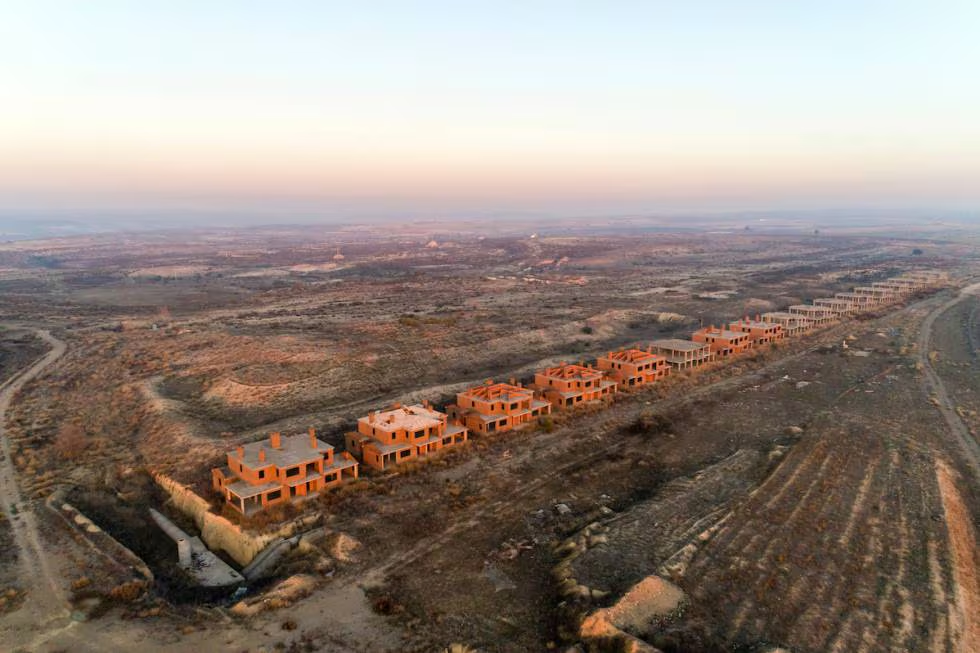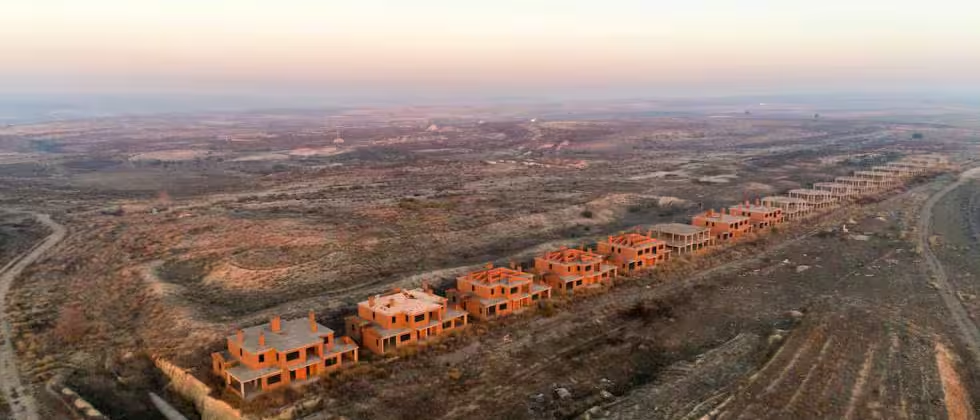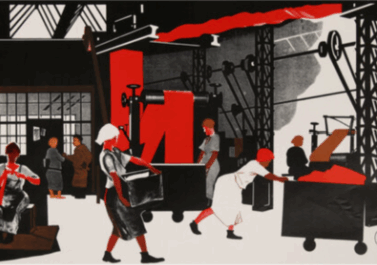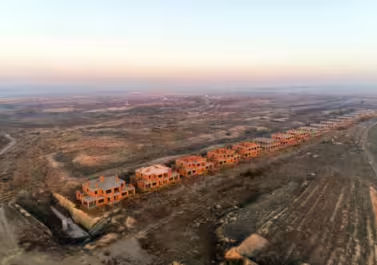
By Emmanuel Rodríguez, translated from Zona Estrategia
We translated this article as a contribution to the debate about how class struggle is contained in the western hemisphere, a previous text on ‘The short winter of inflation’ can be found here. We are not sure whether house property ownership in itself is a major indicator for the integration of the working class. In Bulgaria nearly every working class family owns their house, but at the same time nearly everyone leaves the country to work abroad. The article by Rodriguez focuses on the property sphere and formal education, but perhaps underestimates the role of general careers within workplaces, in particular once native workers become supervisors of recently migrated workers. The emphasis on the ‘hidden’ service proletariat that is exploited with little capital investment is not unimportant, but there are also a lot of ‘hidden’ normal jobs in the essential industries – from transport, to energy, to food processing, to hospitals, to general manufacturing – where workers still play a major role when it comes to social changes and where we cannot assume that they have primarily been integrated by home ownership. The so-called ‘new professional’ class, which is portrayed as the main class element of the neo-liberal era, is only a relatively small segment of the general working class. For us it remains an open task to understand the actual material link between the class position of this professional youth and their political expressions such as Podemos or the ‘movement of the squares’ 15M. [1]
Intro
Emmanuel Rodriguez, sociologist, historian and editor of Traficantes de Sueños, has carried out an extensive research process on the institutional evolution and political economy in Spain. In his works he studies the mechanisms of accumulation and reproduction of capital, for example, the processes that have taken place from Franco’s developmentalism in the 1950s, to the years of the financial and real estate bubble (which he describes in ‘Fin de ciclo – Financiarización, territorio y sociedad de propietarios’, written in 2010 with Isidro López), to the austerity policies imposed after the systemic capitalist crisis of 2008. Rodríguez has also analysed the regime crisis that opened with the 15M cycle of protests and the subsequent attempts to impact on the institutions through new parties, especially the experience of Podemos in La política en el ocaso de la clase media, el ciclo 15M-Podemos (2017). His latest book El efecto clase media (2022) dissects the constitution of the middle classes in Spain and the crisis they are going through.
The question of the integration of the working class into the state apparatus has always been a thorny issue within the revolutionary tradition. Could you explain how it has influenced subsequent readings by the ‘left’ in liberal democracies?
The problem is contained within the ‘left’ tradition itself, as well as in most Marxist currents. Not only is there a theoreticall deficit in considering the state, or the true historical magnitude of the state-capital association, but it also occurs in practice. At least since the Second International, there is no politics other than that which is organised around and towards the state. In this sense, Leninism and revolutionary Marxism (with a few exceptions: councilism, Operaismo [2], etc.) have not gone beyond being the left version of a politics of reform, around and within the state, with often disastrous effects.
It would seem, however, that the forms of conflict marked by the social antagonism of the 19th and early 20th centuries (rich and poor, bourgeois and proletariat, owners and dispossessed, etc.) no longer exist today. Despite this, the rich and the poor continue to exist. You identify the figure of the middle class as the key to avoiding this conflict between rich and poor. What are the main elements that define this social position?
First of all, it is a matter of considering the middle class as a social category that anthropologists would call emic. [3] The rich societies of the planet define themselves, in their vast majority, as ‘middle class’. In the case of Spain, between 70 and 80 % of the population has been answering the question, ‘what social class do you belong to’ by saying that they belong to the middle class. In political terms, this means that the social majority considers itself to be on the margin (in ‘another place’, in the ‘right middle’) of the old polarities that articulated the class struggle. The question, then, should be how is it possible for class societies, in which there is a clear concentration of wealth and effective political power, to achieve such a degree of substantive consensus on the question that has determined the long history of modernity? Here again, the capacity of the state to produce this ‘middle class effect’, i.e. to deactivate, correct and neutralise any potential conflict over real inequalities of political and economic power, is central.
Perhaps one of the most interesting analytical elements of your latest book is that it moves away from sociology’s major headache of defining the middle class through different indicators, as the various schools of thought did, to propose instead a subjective approach. What led you to propose this approach?
It is not really a question of considering a subjective perspective, but rather of taking seriously the fact that social processes exist in the double dimension of their objectification – in specific social institutions – and their subjectification – in forms of identification, action, etc. In fact, it would suffice here to consider the old tradition of social history, from E. P. Thompson onwards, to affirm that classes do not exist as such, but are made out of a set of complex materials that go beyond structural determinations. Experience, the reworking of old traditions and actual struggles are as or more decisive than ‘structural’ elements in producing the forms of subjectivation that give rise to classes.
Property is actually a central element in the domestic financial game, in the leverage, investment and income-earning capacities of many sectors of society.
On the other hand, and in relation to the more classical Marxist readings, I believe that the main contribution of my works (which are often collective) is twofold. On the one hand, I believe that they contribute a new consideration of the financialisation of domestic economies, what we could call the centrality of ‘popular capitalism’, which in the case of European countries (and especially in the case of Spain) takes on materiality fundamentally through property ownership. Property is, in fact, a central element in the domestic financial game, in the capacity for leverage, investment and obtaining income for many social sectors. Today, property is as important a determinant of class status as socio-professional position. In fact, having or not having one or more properties creates significant social differences, which are manifested in the income they produce (rents, profits) and which are reproduced through inheritance. On the other hand, our second contribution lies in reconsidering the role of the state as a social engineer, in its specific capacity to produce social structure and thus class identifications; or even to overcome class society, through the ‘middle class effect’.
This open approach allows for the construction of a non-closed, much more flexible framework of ordering. However, there are five instances to which you attach greater centrality in the reproduction of the middle class. Education, the role of the welfare state, property, the family and the figure of ‘the modernised’. Briefly, could you summarise what role these elements play in the generation of the social imaginary of the middle class?
It is actually a question of including more elements in the analysis than are usually considered when analysing what is normally called the social structure. Hence the centrality of property, already mentioned. Also the importance of academic qualifications (which undoubtedly has a long literature behind it), in schooled societies, and in which educational credentials are a determining element of socio-professional position. The family, too, as the primary agent of class reproduction and social position, and in the long-running crisis of neoliberal capitalism, becomes even more relevant through educational investment, inheritance and the ability to provide or not a framework of relative security. The respective ideological elements, based on the individual’s confidence in his or her capacities for social achievement/fulfilment, etc.
The global capitalist crisis of the 1970s provoked at the same time the crisis of the Keynesian-Fordist regulatory system. From this moment onwards, the pillars of welfare and the state as a regulator went into crisis with the irruption of new forms of financial accumulation. In ‘Fin de ciclo’ you identified, together with Isidro López, that the integration of a large part of family units in the processes of financialisation constituted one of the key points for relaunching a cycle of accumulation by means of personal indebtedness and asset price rises. How did this Keynesianism of asset prices shape the structure of the middle classes in Spanish society prior to the 2007 crisis?
It shaped the middle classes in a fundamental way, no doubt. Consider the history of a country that underwent a process of industrialisation in fits and starts and stops, such as the long Spanish post-war period spanning almost twenty years (from 1939 to 1956-1959). It is also a country with a pattern of industrial concentration as geographically unequal as Italy’s, and a country that is undergoing a rapid process of deindustrialisation that began as early as the 1970s. However, it is an economy with a strong specialisation in tourism and equally rapid tertiarization [4], in which the territorial circuit of capital (housing construction, infrastructures, tourism, etc.) has been central in generating extremely profitable accumulation dynamics for local capitalist agents (banks, construction companies, developers).
In the same country, Franco’s dictatorship and later on democracy relied on the promotion of real estate as a pillar of social stabilisation and the moralisation of the working class. In Spain, since the 1970s, three out of every four households have owned at least one home, and this figure reached 82% in the 2000s. If we consider the great growth cycle of the Spanish economy in democracy (between 1997 and 2008), we observe that during that period the value of assets in constant terms in the hands of families multiplied by a factor of 3.5, the volume of loans to families by a factor of 10 and the increase in household consumption by 90%, all in an economy in which wages remained practically stagnant. This is what allowed the Spanish economy to grow faster during that decade than any other major European economy, and its real estate bubble was certainly more intense than that of the US or the UK.
It is interesting to consider that the effects in terms of increased wealth, profits from real estate capital and access to credit left out only a narrow minority of Spanish society, no more than 20% and largely made up of the most recent migrants. During this period, the social consensus regarding the neoliberal real estate-financial model was practically absolute. However, the 2007 crash brought into crisis many of the elements that materially founded the middle class, accelerating and aggravating the processes of the ‘muddling through’ or improvisations [hojaldramiento] of this segment of Spanish society. Could you elaborate on how some of the elements of the economic crisis serve to explain the material foundations of a movement like 15M?
What began in 2008 could be considered phase B of this economic cycle based on real estate and finance. Families that had been converted into investment companies then underwent a kind of massive process of creative destruction. Which in more banal terms implied rapid falls in house prices, bankruptcies of many families (aggravated by a wave of redundancies) and evictions. It is estimated that in one decade one million households lost their main home. What has taken place since the movement in the squares of 2011, what we call the 15M movement in Spain, is the conversion of social crises into political crises. In 2011, Spanish society found itself on the edge of the abyss, pushed by the austerity policies of the European Union. Unemployment rose from 2.5 million to more than five million in 2013, public debt soared from 40 % to nearly 100 %, the cuts and degradation of public services were spectacular, even civil servants were threatened in their working conditions and their most elementary guarantees. The financial crutches that had been in place for two or three decades were broken, and the disastrous consequences of the application of the neo-liberal recipe became clear.
In this sense, what were the leading figures in this movement? What tendencies, which later found their full expression in the run for the institutions, were anticipated in the political protagonism that groups such as Youth Without a Future [Juventud Sin Futuro] occupied within this movement?
It is interesting to underline that the components that led the protests, and that in some way galvanised the identification of the majority of people with 15M, were not the social sectors most affected by the crisis. It was a young generation born in the 1980s, or shortly before, that occupied most of the squares, organised the protests and produced the ‘technopolitical’ dynamic that articulated the movement in the social networks. It was also the segment with the best position within that generational range: university graduates, children of the professional middle class, but marginalised by the economic crisis, relegated to a precariousness that is too widespread over time and certainly separated from the promises of career and personal fulfilment to which they seemed destined.
This type of social composition also explains the success of the protests: in the boy or girl with a Master’s degree but ‘without a future’ was somehow contained the representation of the general collapse of the country. It also explains the conservative nature of the movement, although it also raised the banner of democracy against the ‘financial dictatorship’, corruption and the political caste. Undoubtedly, in its massiveness and in the processes of politicisation that 15M encouraged, there was also a tendency towards the radicalisation of democracy, and towards possible horizons of social alliance with the hardest hit social sectors, as was proven in the housing unionism that emerged in those years. But this ‘restorative’ and conservative element cannot be disregarded, as it was the one that eventually became dominant.
Within this Youth Without Future, as opposed to the classic figure of the political organiser, the figure of the communication expert has stood out, who, following the political postulates of populism theorised by Mouffe and Laclau, has played a decisive role. This partly explains the triumph of a segment of Podemos after the assemblies at Vistalegre [5] over other fractions that made up the political party. On several occasions you have pointed out that this is because left politics is a politics without a people or political subject, reduced to political positions of institutional representation and opinion-makers, where there are no grassroots forms that can establish a kind of movement-party dialectic. Could you elaborate on this thesis?
The fact that this type of social composition was dominant in the movement also explains, albeit partially, the subsequent political drift. Once the most creative and powerful phase of mobilisation between 2011 and 2013 had been exhausted, many voices within the active sectors began to speak in terms of building an electoral alternative. Podemos was the most finished result of this option. It was not the only one: there were municipal candidates such as Ada Colau in Barcelona and people from other previous movement experiences. But it was the most complete and enduring response.
The emergence of Podemos in 2014 significantly changed the Spanish political landscape: it practically broke the two-party system and, for some time, seemed to represent a novel and progressive political option, at times almost aiming at a rupture. However, Podemos also represented a direct way of institutionalising the 15M event. On the one hand, the party quickly assumed a sort of business-like political modality. All decision-making power was reduced to the founding core, which, all too quickly, broke up in a never-ending factional battle that has lasted to this day. Along the way, several tens of thousands of people who had organised themselves in the so-called ‘circles’, the grassroots assemblies of Podemos, were ‘sacrificed’. This huge political mass abandoned the organisation as it was reduced to a mere sidekick in Pablo Iglesias’ plebiscites, election campaigns and the factional struggles of the leadership.
On the other hand, the party’s ‘leaders’ justified from the outset the need to dispense with a broad and plural militancy within the organisation. Iglesias and Errejón adopted Laclau and Mouffe’s ‘sophisticated’ theory of populism. Having become sorcerer’s apprentices, they entrusted everything to a model of direct communication with the ‘people’, which they intended to organise from television sets and the political talk show, then converted into a prime time product. The naivety of Podemos today is almost touching.
Within the framework of this policy, which had become all about discourse and communication, Podemos was soon torpedoed by aggressive media campaigns, encouraged by practically the entire political and media spectrum. Abandoned, the Podemos leadership was literally shredded. Barely eight years later, none of the main protagonists of the first Podemos is still at the forefront of politics. The leaders of Sumar (the Podemos successor) are not new figures, but they were secondary in those first ‘heroic’ years. Any possibility of trying out a new type of political experience, halfway between the party and the movement, was left in the gutter.
The process of capitalist restructuring already mentioned also means that the ‘new proletariat’ of services that the neoliberal regime of accumulation has generated responds to particular characteristics, which, on many occasions, tend to correspond to the very reproduction of a middle class, let us call it ‘pro[fessionals]’. What impacts does it have when imagining a new cycle of struggles to find a proletariat that is in many ways redundant, produces little value or is easily replaceable?
One of the most relevant lessons about the cycle of mobilisation that pushed 15M is that surely the social crisis produced in 2008 was not enough to break the mirage of the middle class as a social majority, if we understand this as a de facto or aspirational (ideological) reality. I believe that the fear of a larger social breakdown was also what triggered the response of European policymakers, who after the Greek restructuring experiment decided to slightly lift the brakes with the ECB’s public debt purchase policies and Quantitative Easing (QE). The end of austerity policy expanded governments’ room for manoeuvre. Those maneuvers acted as a firewall against the eruption of protest in several countries in 2011.
The containment of the social crisis in turn dissolved the possibilities of alliance between the middle classes in the process of proletarianisation, and the already proletarianised and overexploited segments. These segments, for the Spanish case, can be considered under the figure of a sort of multinational proletariat of services, working in catering, tourism, logistics, commerce, domestic service, sex work, etc. This proletariat is therefore employed in relatively marginal economic sectors: personal and market service activities, generally with a very low organic composition of capital and low productivity rates. This service proletariat is highly fragmented in terms of labour, and also in terms of its internal composition (migrants, nationals or not, etc.), and also has very little structural power within the global chain of value production. It is therefore a socially invisible sector, which at the moment has little organisational capacity. In a way, it is the big elephant in the room of middle-class society. This new proletarian figure is the big question mark and the great political promise for the future.
Finally, I would like to ask you a question: what is communism today? Is it possible to rethink community in a society as fragmented as ours, as individualised, with such atrophied subjectivities? What can we rescue from the boot of the struggles that have already taken place in order to think and articulate the struggles of the present?
I think what we always have to consider is that communism is not a model of an ideal society, much less a political form (in the manner of the socialist states), it is the ‘real movement’ that undermines the present society. What we have to be able to do is to decipher those forces that operate today as the communist tendency of the future society.
[1]
https://en.wikipedia.org/wiki/Anti-austerity_movement_in_Spain
[2]
https://www.angryworkers.org/2021/10/03/the-renaissance-of-operaismo-wildcat/
[4]
Tertiarisation: expansion of the so-called ‘service sector’
[5]
https://www.opendemocracy.net/en/can-europe-make-it/rise-of-podemos-and-its-peoples-assembly/



